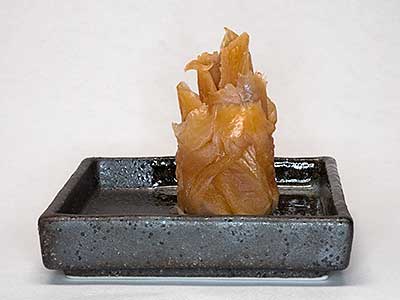January 28, 2013
Amuse-Bouche

truite fumée
(smoked trout)
I caught my first fish, an 8-inch long trout, on the South Fork of the Trinity River in Northern California in the summer of 1953. I used a nylon drop line with a salmon egg impaled on my hook. I was five years old. It was my first time fishing. It was my last time fishing. On a couple of other occasions in the last 60 years I’ve accompanied others while they fished, but I’ve never picked up a drop line or rod again.
That fish tasted mighty good that morning. It was pan-fried whole in butter along with the dozen or so caught by the guy who had brought me out to the river. The fried trout was served along with eggs and Cream of Wheat for breakfast. The whole breakfast was cooked on a wood-fired stove in a large log-walled house that was reachable only with a four-wheel drive vehicle. This meal could never be recreated these days with store-bought trout. Not only are they not quite as fresh, but I can’t find small ones any more. Plus, they only seem to be available without bones.
The other fish that I liked and started to eat periodically around the same time was salmon in the form of lox. I didn’t know it at the time, but this type of smoked salmon is what technically is called cold-smoked salmon. When properly made without short cuts, the fish is lightly brined, dried thoroughly, and then cold smoked. There is some debate about how hot is cold smoke, but in my opinion it must be sufficiently cold so as to not cook the fish during the smoking process.
In the early days of the Internet, I designed a website for a friend in British Columbia. As a thank-you gift he sent me a Bradley Smoker, which can be either a cold smoker if used in a cool enough climate or a hot smoker. Even starting before the sun comes up on a cold day, in my location it is hard to keep the interior of the smoker below about 40 °C (105 °F), a temperature that can start to cook fish. A little while ago, I noticed that the Bradley folks brought out an adapter kit that moves the smoke generator away from the smoking chamber. With this I’m able to get the temperature of the chamber to approach ambient. During my latest smoking attempt on a pleasant summer day here on the San Francisco Peninsula, I was able to keep the chamber well below 30 °C (86 °F).
Although fish was originally smoked as part of a preservation process that also included salt-curing and or drying, today we tend to smoke to deposit a layer of phenolic molecules on the food’s surface to give it a distinctive smoke flavor and bouquet. Specifically, the compound guaiacol is supposed to be responsible for the smoky flavor and the compound isoeugenol for the aroma.
The day my Bradley cold-smoke adapter arrived, I was busy doing other things so the box was set aside. Even after unpacking and attaching it to my smoker, it was still a month or two before I got around to using it for the first time. My goal was to smoke some trout.
I purchased four whole, boneless trout. (There’s an oxymoron in there somewhere!) After a little minor surgery to clean up the boning process, the fish were placed in a cold, plain, 5% salt-brine solution for an hour in the refrigerator. My fish weighed about 225 g (8 oz) each, so not much curing time was necessary. My goal was a little preservation without producing a salty tasting fish.
Next, the trout were laid out flat on a rack, bellies open, skin side down, and the rack placed in the refrigerator overnight. By the next morning, a decent pellicle had formed and the surface was dry. The dry surface helps the smoke stick better to the flesh.
Early the next morning I loaded the smoke generator with enough hickory sawdust for six hours of smoke and loaded the trout into the smoking chamber. When the time was up, I placed the trout back in the refrigerator to chill. That night, one of the smoked trout was sacrificed to the tasting gods while its brethren were vacuum packed.
When it is time to serve the trout as an amuse-bouche, a package is opened, and the trout cut into thin slices. One fish produces four portions. No other seasoning or flavoring is required.
© 2013 Peter Hertzmann. All rights reserved.
